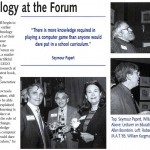Most “visions” are articulated from a close understanding of a specific community – the teachers, administration, students and parents. This vision represents my values and educational pedagogy.
Where does reflection play a role in the ever changing and evolving ecology of technology and learning? Our economy has become one of “attention.” All electronic “screens”, computers, televisions and even a cell phone, demand full attention. When engrossed in a television program, video game, feature film, or even a conversation on a cell phone, “reflection” only occurs when the device is turned off – or not working as expected. “Reflection” then, as it relates to implementing technology in the classroom, is essential for students to make sense of what is going on around them and to question what is assumed. One can sit at the computer and write 100 pages, but without the reflective aspect of thinking about what one has written – time spent proofreading and musing over characters and story lines − one will never polish a written work. My students’ most valuable insights have come when they have finished their work on the computer, and have had time to both think about their work, and share it with the class.
Consequently, one vision I have for technology and its implementation in teaching is to build reflection into the very fabric of the curricular unit, lesson plan, or training session.
With reflection, comes responsibility. How much of our day is spent watching screens – TV screens, computer screens, video game machines, cell phone screens? And how much of that time is spent watching material that we created? Steven Spielberg, Bill Gates, and Annie Leibovitz probably spend a fair amount of time watching things they have created. Their creative index is very high. The more we create, the more we construct knowledge of the world in context, and the stronger our understanding (Piaget). With this understanding comes the responsibility to own what we create. It has become all too easy to send e-mail, instant message, and “chat” on the internet. It has also become too easy to “find” written material from other sources, and not make the attribution. I have worked specifically on the training of faculty, parents and students about the pitfalls, dangers and proper habits of communicating in these new worlds.
Technology also serves diverse learners with various intelligences (Gardner). Linguistic, mathematical and kinesthetic abilities (to name a few) vary greatly with individuals. I have researched and implemented hundreds of lessons using technology to teach every subject – including math, French, social studies, language arts, and even film making and electronic portfolios. Technology has made a tremendous difference in meeting the diverse needs of students and teachers with different intelligences, and benchmarking their performance.



